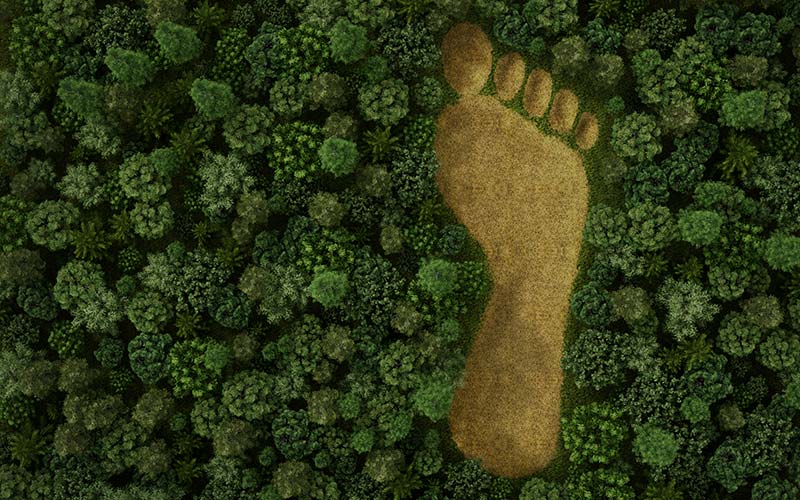La Huella Ecológica es un concepto vital, si queremos conocer realmente el impacto que creamos en el entorno. No manejar sus alcances, haría casi imposible que habláramos de sostenibilidad, ya que no podría conocerse el límite adecuado de una actividad o producción en el ambiente, sin los indicadores y métricas respectivas. En esta breve reflexión, intento aclarar este tema de huella ecológica y brindar una idea respecto al estado de la cuestión, ya que no es un área pacífica.
Lo primero que debemos tener claro, es que la idea de sostenibilidad que se tenga (ya sea para un país, para una región o para una empresa) está ligada por completo a la concepción económica que se maneje. En este sentido, existe en el ámbito un debate respecto a la Economía “Convencional” y la “Economía Ecológica”. A continuación brindo unas breves consideraciones al respecto.
- La Economía convencional:
Muchas veces, al tratar la llamada “ecuación madre” de la economía conocida como función de producción se simplifican sus componentes. De modo tal, se suelen dejar de lado factores que pertenecen al medio ambiente y sin los cuales cualquier tipo de producción sería impensable. La raíz de ello proviene de la presentación de la función Cobb-Douglas, que debe su existencia al economista estadounidense Paul Douglas, quién en 1927 observó que en EEUU la distribución de la renta entre el trabajo y el capital se había mantenido constante a lo largo del tiempo (70-30 respectivamente). Al notar esto, acudió al matemático Charles Cobb, resultado de lo cual surgió el modelo (Sancho, 2015).
En este caso, Y es la producción, mientras que A es la productividad total de los factores. Esta incluye aspectos de un país que mejoran (o empeoran) el resultado de la interacción entre el capital (K) y el trabajo (L), tales como la tecnología, las instituciones, la desigualdad y la globalización. Por su parte “a” representa la distribución de la renta observada por Douglas, entre el capital y el trabajo.
Como se puede ver, en la ecuación básica de la economía se dejan de lado dos aspectos gravemente importantes. El primero de ellos, como ya se anunciaba anteriormente, es que para producir se necesita más que A (avances tecnológicos e instituciones), K (capital) y L (fuerza laboral). A saber: aire, agua, terreno y otros muchos recursos naturales, según sea el caso, se suelen tomar por sentado. Su gratuidad en muchos casos, así como la escasa (¿nula?) conciencia medioambiental de la época ha contribuido a que ello sea así.
El segundo aspecto medular que ignora la ecuación Cobb-Douglas viene dado por la parte del resultado de la interacción de los factores. Es decir, lo que sugiere la ecuación es que los únicos outputs resultantes son bienes, servicios y riqueza en general. Resalta aquí el hecho de que se deja de lado el tema de los residuos. Este error es tan grave que ignora los contaminantes que se lanzan al medio ambiente por parte de todas las actividades económicas, lo cual debería ser la primera preocupación del desarrollo sostenible. Así, actividades económicas tan importantes como la industria, son vistas desde la economía clásica como meras creadoras de riqueza, obviando los peligrosos y contaminantes residuos que suelen derivarse de su actividad.
2. La Economía Ecológica:
Frente a la postura anterior, surge esta nueva visión del campo, que involucra a la ecología, entendida como: “el estudio de las relaciones entre plantas y animales con sus ambientes orgánicos e inorgánicos, y la economía,como el estudio de la forma en que los seres humanos subsisten, cómo satisfacen sus necesidades y deseos” (Common & Stagl, 2008). En primera instancia, podría pensarse que ambas ramas se encuentran separadas por un abismo infranqueable y que su relación es inexistente. No obstante, los planteamientos más recientes ven que la relación es total y absolutamente ineludible.
Como se puede ver, la economía ecológica parte del enfoque integrador y desecha la visión aislada y/o aséptica de la economía convencional. Así, dentro del primer enfoque, “es el sistema económico el que constituye un subsistema dentro de un sistema más amplio como es la Biosfera, y, por lo tanto, su dinámica está restringida y debe ser compatible con las leyes que gobiernan el funcionamiento de la propia Biosfera (las leyes de la Termodinámica y la Ecología)” (Carpintero, Introducción: la economía ecológica como enfoque abierto y transdisciplinar, 2008). Como se puede ver, se trata de abandonar una visión monetizada del problema económico, donde no todos los problemas de producción se pueden resolver con mayor inversión, compra de capital o incremento de fuerza laboral.
De tal suerte, la economía ecológica incorpora conocimientos científicos de otras ciencias, ya que observa la indivisibilidad de la ciencia económica con relación a las leyes que gobiernan la naturaleza.
3. La Huella Ecológica y la medición de la sostenibilidad.
Algunas instituciones encargadas de estos temas, se inclinan por la versión clásica de la Economía. Tal es el caso del Banco Mundial, que utiliza la denominada “Tasa de Ahorro Genuino” para medir la sostenibilidad. Básicamente consiste en adaptar la función Cobb-Douglas mencionada anteriormente, y compensar el gasto de recursos naturales con inversión en sus otros componentes. De tal suerte, se puede seguir siendo sostenible si se tala un bosque, pero se invierte en educación (por poner un ejemplo bastante simple). De manera muy básica, esta postura podría visualizarse del siguiente modo:

La consecuencia de esta manera de medir la sostenibilidad es que, países que realmente son muy contaminantes, pero cuentan con muchos recursos económicos para reinvertir en capital humano o físico (carreteras, hospitales y escuelas, por ejemplo) son tomados como ejemplos de sostenibilidad. Con este índice, economías como la china o la estadounidense son consideradas sostenibles, logrando así mayor captación de recursos y continuar consumiendo recursos sin consecuencia alguna. Al contrario, países con pocos recursos económicos, pero que realmente no contaminan mucho (como la República Democrática del Congo) son castigados por el resultado del indicador.
Lo cierto del caso es que la medición de la sostenibilidad tiene necesariamente que tomar en consideración el espacio, ya que “este tipo de aproximación permitía aportar una dimensión apropiada a los análisis de la sostenibilidad como una cuestión de escala o tamaño ocupado por el sistema económico dentro de la biosfera” (Carpintero, 2005).
Es así como se arriba al concepto de «Huella Ecológica» que se ha definido como “un indicador ambiental de carácter integrador del impacto que ejerce una cierta comunidad humana –país, región o ciudad- sobre su entorno, considerando tanto los recursos necesarios como los residuos generados para el mantenimiento de producción y consumo de la comunidad” (Elorrieta & Tortajada Martinez, 2003).
En cuanto a la mencionada implicación territorial, este indicador se distingue (entre otras cosas) del utilizado del Banco Mundial porque toma conciencia de la superficie como factor de producción. En este sentido “(l)a huella ecológica se expresa como la superficie necesaria para producir los recursos consumidos por un ciudadano medio de una determinada comunidad humana, así como la necesaria para asimilar los residuos que genera, independientemente de la localización de éstas áreas”. (Elorrieta & Tortajada Martinez, 2003).
William Rees y Mathis Wackernagel son los autores de este indicador medioambiental en 1996. Y lo han definido como “el área de territorio ecológicamente productivo (cultivos, pastos, bosques o ecosistema acuático) necesaria para producir los recursos utilizados y para asimilar los residuos producidos por una población definida con un nivel de vida específico indefinidamente, donde sea que se encuentre esta área” (Elorrieta & Tortajada Martinez, 2003). Una cuestión muy importante es que se cambia el punto de enfoque en cuanto a la sostenibilidad, pasando de centrarse en analizar “cuánta población puede mantener sosteniblemente una región determinada”, siendo que lo verdaderamente relevante para la medición de la huella ecológica es: “¿qué superficie de suelo productivo es necesaria para mantener una población concreta indefinidamente, sea donde sea que se encuentre este suelo?” Rees & Wackernagel en (Carpintero, El metabilismo de la economía española, 2005).
Actualmente, el sitio web Global Footprint Network analiza distintos países utilizando esta metodología. El resultado es mucho más preciso que aquel utilizado por el Banco Mundial y deja muy mal paradas a distintas naciones, incluido Costa Rica. Este país cuenta con una biocapacidad per cápita de 1.5 GHA, mientras que su huella ecológica es de 2.8GHA. Ello quiere decir, que mantiene un déficit de su biocapacidad -1.3GHA. (Global Footprint Network, 2016). El punto de inflexión fue la década de los 90’s, momento en el cual empezó a utilizar más recursos de los que su superficie le permite obtener de un modo sostenible. De continuar por esa vía, su situación ambiental se vería sumamente comprometida y, se daría el caso de que uno de los países con mayor biodiversidad del mundo (aproximadamente un 5% de la biodiversidad calculada para el planeta, esto es, un total de 94,753 especies conocidas) podría perder toda esta riqueza, comprometiendo la salud de sus habitantes y el mundo en general.
4. A modo de cierre
Es importante estar consciente de estos debates, ya que afectan a todos los habitantes del planeta. La economía convencional ignora los recursos naturales, actuando como si fueran inagotables, o como si los residuos que producimos pudieran ser absorbidos por el planeta sin consecuencia ninguna y de manera indefinida. Sin embargo, los avances científicos nos muestran que la realidad es otra.
La economía ecológica ha levantado la mano y ha demostrado dentro de la comunidad científica que los recursos y los residuos son dos elementos que deben ser tomados en cuenta dentro de cualquier sistema económico. Ahora entendemos que la economía opera dentro de la bioesfera, y en ese sentido juega con sus reglas. Ignorar estos hechos no solo es incorrecto, sino insensato. Ya que implica negar una realidad ineludible, con consecuencias nefastas para la vida en el planeta tal y como la conocemos. La huella ecológica es el indicador que mejor se ajusta a tales parámetros de cientificidad, rigurosidad y precisión. La premisa es tan sencilla como cierta: no se puede comer dinero. Por lo tanto, es sumamente importante conocerlo, manejarlo y demandar su uso a las autoridades competentes. En la página www.footprintnetwork.org se pueden observar muchos datos y conocer más al respecto, por lo que extiendo una invitación a conocer este sitio web y aprender más respecto de estos temas.




